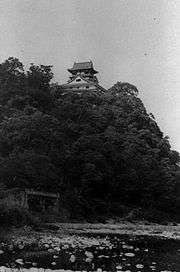Inuyama Castle
| Inuyama Castle | |
|---|---|
| 犬山城 | |
| Inuyama, Aichi Prefecture, Japan | |
|
Tenshu of Inuyama Castle | |
| Coordinates | 35°23′18″N 136°56′21″E / 35.38833°N 136.93917°ECoordinates: 35°23′18″N 136°56′21″E / 35.38833°N 136.93917°E |
| Height | 19 m (62 ft) |
| Site history | |
| Built | 1440 |
| Built by | Oda Hirochika |
| Garrison information | |
| Past commanders | Oda Nobuyasu |
| Occupants | Oda clan, Naruse clan |
Inuyama Castle (犬山城 Inuyama-jō) is located in the city of Inuyama, Aichi Prefecture, Japan. The castle overlooks the Kiso River, which serves as the border between Aichi and Gifu prefectures. Inuyama Castle is one of only 12 surviving Japanese castles built before the Edo period.
History

Inuyama Castle is often claimed as the oldest castle in Japan. Its original construction was completed in 1440. According to Engishiki (a Heian Period-book), Harigane Shrine (a Shinto shrine) was moved to make way for the castle. That structure has been heavily augmented over time, and the current towers were completed in 1537, by Oda Nobuyasu, Oda Nobunaga's uncle. Though the antiquated architectural style of the watchtower atop the tenshu has in the past led many historians to believe this to be the oldest extant tenshu in Japan, that honor goes to Maruoka Castle, built in 1576. Construction on the main tenshu (donjon) at Inuyama began in 1601, and continued through 1620.[1]
The castle was the center of power for the Naruse clan, retainers of the Matsudaira clan and rulers of the Inuyama Domain. Inuyama Castle was unique in Japan in that it was privately owned. The donjon (tenshu) has been designated as national treasure. However, it was seized by the Japanese government as part of the Meiji Restoration. In 1891, the castle was damaged in the Great Nōbi earthquake, and it was returned to the Naruse family in 1895, on the condition that they repair and maintain it. In 2004, ownership of the castle was turned over to a foundation set up by the Aichi Prefecture's Board of Education.[2]
It was long believed that the donjon of Inuyama Castle was moved to the castle from Kanayama Castle in 1599, until such theory was disproved as a result of examination through a large scale restoration work, involving the dismantling of the donjon, carried out between 1961 and 1965.[3]
Castle Rulers
The rulers of Inuyama Castle are listed below in order with their dates of reign in parentheses. There were no castle rulers from 1612–1617 and 1869–1895.
- Pre-Naruse Clan
- Oda Nobuyasu (1537–1547)
- Oda Nobuyuki (1547–1564)
- Ikeda Nobuteru (1570–1581)
- Oda Nobufusa (1581–1582)
- Nakagawa Sadanari (1582–1584)
- Ikeda Nobuteru (1584)
- Katō Yasukage (1584, proxy ruler)
- Takeda Kiyotoshi (1584–1587, proxy ruler)
- Hijikata Katsuyoshi (1587–1590, proxy ruler)
- Nagao Yoshifusa (1590–1592, proxy ruler)
- Miwa Gorōemon (1592–1595)
- Ishikawa Mitsuyoshi (1595–1600)
- Ogasawara Yoshitsugu (1601–1607)
- Hiraiwa Chikayoshi (1607–1612)
- Naruse Clan
- Naruse Masanari (1617–1625)
- Naruse Masatora (1625–1659)
- Naruse Masachika (1659–1703)
- Naruse Masayuki (1703–1732)
- Naruse Masamoto (1732–1768)
- Naruse Masanori (1768–1809)
- Naruse Masanaga (1809–1838)
- Naruse Masazumi (1838–1857)
- Naruse Masamitsu (1857–1869, 1895–1903)
- Naruse Masao (1903–1949)
- Naruse Masakatsu (1949–1973)
- Naruse Masatoshi (1973–2004)
Related exhibits
Entry into Inuyama Castle also allows visitors to enter into the Inuyama Artifacts Museum (犬山市文化史料館 Inuyama-shi Bunka Shiryō-kan) and the Karakuri Exhibition Room (からくり展示館 Karakuri Tenjikan). Both of the exhibitions focus on cultural and historical artifacts of the city.
See also
References
- ↑ Young, David and Michiko. Introduction to Japanese Architecture. Hong Kong: Periplus Editions, 2004. p100.
- ↑ (Japanese)http://www.inuyamajohb.org/
- ↑ Nanjō, Norio; Tatsuya Naramoto (1989). Nihon no meijō kojō jiten (in Japanese). Hankyū Communications. p. 240.
- Schmorleitz, Morton S. (1974). Castles in Japan. Tokyo: Charles E. Tuttle Co. pp. 117–120. ISBN 0-8048-1102-4.
- Motoo, Hinago (1986). Japanese Castles. Tokyo: Kodansha. p. 200 pages. ISBN 0-87011-766-1.
- Mitchelhill, Jennifer (2013). Castles of the Samurai:Power & Beauty. USA: Kodansha. ISBN 978-1568365121.
External links
![]() Media related to Inuyama Castle at Wikimedia Commons
Media related to Inuyama Castle at Wikimedia Commons